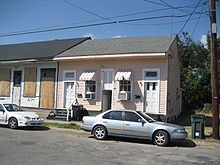- Dogtrot house
-
The Autrey House (c. 1849), a typical one-story hewn-log dogtrot in Dubach, Louisiana. On the National Register of Historic Places (NRHP).

 The John Looney House (c. 1818), a rare two-story hewn-log dogtrot near Ashville, Alabama. On the NRHP.
The John Looney House (c. 1818), a rare two-story hewn-log dogtrot near Ashville, Alabama. On the NRHP.
 Urban variation of a "dog-trot": Creole cottage row house with narrow dog-trots, New Orleans.
Urban variation of a "dog-trot": Creole cottage row house with narrow dog-trots, New Orleans.
The dogtrot, also known as a breezeway house, dog-run, or possum-trot, is a style of house that was common throughout the Southeastern United States during the 19th and early 20th centuries.[1][2] Most theories place its origins in the southern Appalachian Mountains. Some scholars believe the style developed in the post-Revolution frontiers of Kentucky and Tennessee. Others note its presence as far east as the Piedmont of the Carolinas from an early period.[1][3]
Architects continue to build dogtrot houses using modern materials but maintaining the original design.[4]
Contents
Design
A dogtrot house historically consisted of two log cabins connected by a breezeway or "dogtrot", all under a common roof. Typically one cabin was used for cooking and dining while the other was used as a private living space, such as a bedroom. The primary characteristics of a dogtrot house is that it is typically one or 1 1⁄2-stories, has at least two rooms averaging between 18 to 20 feet (5.5 to 6.1 m) wide that each flank an open-ended central hall. Additional rooms usually take the form of a semidetached ell or shed rooms, flanking the hall to the front or rear.[1][3]
The breezeway through the center of the house is a unique feature, with rooms of the house opening into the breezeway. The breezeway provided a cooler covered area for sitting. The combination of the breezeway and open windows in the rooms of the house created air currents which pulled cooler outside air into the living quarters efficiently in the pre-air conditioning era.[5]
Secondary characteristics of the dogtrot house includes placement of the chimneys, staircases, and porches. Chimneys were almost always located at each gable end of the house, with each serving one of the two main rooms. If the house was 1 1⁄2 or the rarer two stories, the necessary staircase was usually at least partially enclosed or boxed-in. The stairway was most commonly placed in one or both of the main rooms, although it was sometimes placed in the open hallway. Although some houses had only the open central hall and flanking rooms, most dogtrots had full-width porches to the front and/or rear.[1][3]
Surviving homes
The town of Dubach in Lincoln Parish, Louisiana, has several surviving dogtrot houses. In 1990, it was nicknamed the "Dogtrot Capital of the World" by the Louisiana State Legislature.[6][7]
The estate known as "Ranch Azalee" in south Webster Parish in north Louisiana, formerly owned by the late State Senator Harold Montgomery, was originally of dogtrot design, having begun ca. 1840 as the James Jackson Bryan House. In 1999, Ranch Azalee was added to the National Register of Historic Places.[8]
References
- ^ a b c d Gamble, Robert (1990). Historic architecture in Alabama: a guide to styles and types, 1810-1930. Tuscaloosa: University of Alabama Press. pp. 24–29. ISBN 0817311343.
- ^ "Dog-Run Houses". Texas State Historical Association. Texas State Historical Association. http://www.tshaonline.org/handbook/online/articles/cfd01. Retrieved July 17, 2011.
- ^ a b c McAlester, Virginia; McAlester, Lee (1986). A Field Guide to American Houses. New York: Alfred A. Knopf. pp. 83–85. ISBN 0394510321.
- ^ "Dogtrot House, Poplarville, MS Waggonner & Ball Architects"Architectural Record, By Ingrid Spencer. Retrieved on 2008-08-11.
- ^ "Dogtrot House – Vernacular", Architecture Week, Great Buildings. Retrieved on 2008-08-11.
- ^ "News Notes: Dogtrot Capital Receives a New Find", Louisiana Life magazine (November 21, 2006). Retrieved on 2008-08-09.
- ^ Town of Dubach, Louisiana Home Page. Retrieved on 2008-08-09.
- ^ Louisiana historical marker, Ranch Azalee, Harold Montgomery Road, Webster Parish, Louisiana
External links
Categories:- American architectural styles
- House types
Wikimedia Foundation. 2010.

